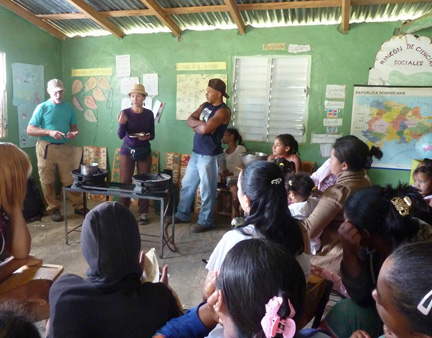By Kevin Gray
For the past year-and-a-half, Paul Kenyon ’71 has served as a Peace Corps appropriate technology developer in the Dominican Republic. He assists the local people with challenges, helping them make effective use of available resources through composting, water-collection systems, harnessing wind and solar power, and more.

Paul Kenyon ’71 (far left) demonstrates fuel-conserving method for cooking rice in Costillo.
Much of what he teaches is basic. For example, since gas is so expensive, Kenyon has provided classes that demonstrate ways to use gas-based fires to cook multiple food items at once and to conserve gas by preparing grains that will finish cooking after the fire is turned off.
“We cook rice for 10 minutes, heating the grain through to the boiling point of water, as hot as we can get it without a pressure cooker,” he explains. “Then we wrap the pot in some insulating material, and the captured heat cooks it the rest of the way.” The method takes more time, but uses much less fuel.
Other projects—such as ensuring anchors for a bridge over a river—require more expertise from Kenyon.
Read Kenyon’s blog about his experience
A mechanical engineering graduate, Kenyon designed meteorological towers and wind resources sensors for NRG Systems for 12 years before starting his own company, Cumulus Engineering LLC in Bridport, Vt.
An environmentalist and avid recreational sports participant, Kenyon has lived off the grid for 30 years. His home in Bridport relies on power provided by the wind and sun, and he uses a gasoline-powered generator only when “desperately needed.”
The system at his home can go out unexpectedly, similarly to the situation in the Dominican Republic, where electricity is very intermittent. “It can quit on you any time of day or night. People have generators and solar panels—double building their infrastructure to provide a convenient level of electricity.”
While Kenyon says that he fits the aphorism that many people use their time in the Peace Corps to find themselves, he notes that his journey began at Lafayette.
“Lafayette offered me a doorway to the world of the scientist as a design engineer,” he says. “I worked directly with nature—atmospheric phenomena such as rime icing, in my case—as I designed and developed instruments to measure aspects of the environment. It has been a gift and a rich pursuit. It led me to learn more, and doors keep opening for me to learn more.”
Kenyon says Lafayette taught him classical physics and gave him the tools to apply physics as a mechanical engineer. “Physics is at the heart of science and is perhaps the most true way to learn how our universe works. Lafayette offered me keys to doors that are linking my adult life with my childhood, knitting them together and, now, my Peace Corps service offers me another way to examine and apply those keys.”
Remaining connected to the College, Kenyon has attended several gatherings for prospective students in Burlington and has given presentations on campus about his physics analysis of the collapse of the World Trade Center buildings in September 2011. Out of curiosity he calculated how fast the buildings could have fallen if gravity truly provided the only event energy.
Kenyon’s first adventure of personal discovery came in the late 1970s during a time of crisis. The avid outdoorsman took more than two years to bicycle around the world. Notably, he traveled through Iran two months before the fall of the Shah and was amazed by the natural beauty and the “endearing local people” in Afghanistan.
“That trip saved my life,” Kenyon says. “This trip is about changing direction.”
“I joined the Peace Corps because I recognized the need to change aspects of myself so that I could live more happily and constructively when I got back…if I got back,” writes Kenyon in his blog. “That was one of the risks—actually finding my true calling…like putting oneself in the path of possible adventure and actually encountering one, getting what you dared to ask for, so that you stay and do the new thing you’ve found within yourself.”
